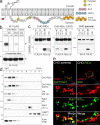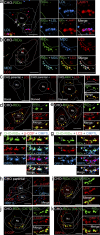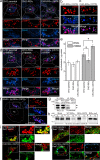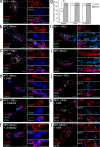Adenovirus RID-alpha activates an autonomous cholesterol regulatory mechanism that rescues defects linked to Niemann-Pick disease type C
- PMID: 19948501
- PMCID: PMC2779231
- DOI: 10.1083/jcb.200903039
Adenovirus RID-alpha activates an autonomous cholesterol regulatory mechanism that rescues defects linked to Niemann-Pick disease type C
Abstract
Host-pathogen interactions are important model systems for understanding fundamental cell biological processes. In this study, we describe a cholesterol-trafficking pathway induced by the adenovirus membrane protein RID-alpha that also subverts the cellular autophagy pathway during early stages of an acute infection. A palmitoylation-defective RID-alpha mutant deregulates cholesterol homeostasis and elicits lysosomal storage abnormalities similar to mutations associated with Niemann-Pick type C (NPC) disease. Wild-type RID-alpha rescues lipid-sorting defects in cells from patients with this disease by a mechanism involving a class III phosphatidylinositol-3-kinase. In contrast to NPC disease gene products that are localized to late endosomes/lysosomes, RID-alpha induces the accumulation of autophagy-like vesicles with a unique molecular composition. Ectopic RID-alpha regulates intracellular cholesterol trafficking at two distinct levels: the egress from endosomes and transport to the endoplasmic reticulum necessary for homeostatic gene regulation. However, RID-alpha also induces a novel cellular phenotype, suggesting that it activates an autonomous cholesterol regulatory mechanism distinct from NPC disease gene products.
Figures








Similar articles
-
Biophysical impact of sphingosine and other abnormal lipid accumulation in Niemann-Pick disease type C cell models.Biochim Biophys Acta Mol Cell Biol Lipids. 2021 Aug;1866(8):158944. doi: 10.1016/j.bbalip.2021.158944. Epub 2021 May 1. Biochim Biophys Acta Mol Cell Biol Lipids. 2021. PMID: 33892149
-
Hydroxypropyl-beta and -gamma cyclodextrins rescue cholesterol accumulation in Niemann-Pick C1 mutant cell via lysosome-associated membrane protein 1.Cell Death Dis. 2018 Oct 3;9(10):1019. doi: 10.1038/s41419-018-1056-1. Cell Death Dis. 2018. PMID: 30282967 Free PMC article.
-
The pathogenesis of Niemann-Pick type C disease: a role for autophagy?Expert Rev Mol Med. 2008 Sep 10;10:e26. doi: 10.1017/S146239940800080X. Expert Rev Mol Med. 2008. PMID: 18782459 Free PMC article. Review.
-
Accumulation of sphingomyelin in Niemann-Pick disease type C cells disrupts Rab9-dependent vesicular trafficking of cholesterol.J Cell Physiol. 2020 Mar;235(3):2300-2309. doi: 10.1002/jcp.29137. Epub 2019 Sep 6. J Cell Physiol. 2020. PMID: 31489965
-
Cholesterol in Niemann-Pick Type C disease.Subcell Biochem. 2010;51:319-35. doi: 10.1007/978-90-481-8622-8_11. Subcell Biochem. 2010. PMID: 20213549 Free PMC article. Review.
Cited by
-
Adenovirus early region 3 RIDα protein limits NFκB signaling through stress-activated EGF receptors.PLoS Pathog. 2019 Aug 19;15(8):e1008017. doi: 10.1371/journal.ppat.1008017. eCollection 2019 Aug. PLoS Pathog. 2019. PMID: 31425554 Free PMC article.
-
Adenovirus RIDα uncovers a novel pathway requiring ORP1L for lipid droplet formation independent of NPC1.Mol Biol Cell. 2013 Nov;24(21):3309-25. doi: 10.1091/mbc.E12-10-0760. Epub 2013 Sep 11. Mol Biol Cell. 2013. PMID: 24025716 Free PMC article.
-
Molecular pathways for intracellular cholesterol accumulation: common pathogenic mechanisms in Niemann-Pick disease Type C and cystic fibrosis.Arch Biochem Biophys. 2011 Nov;515(1-2):54-63. doi: 10.1016/j.abb.2011.08.012. Epub 2011 Sep 5. Arch Biochem Biophys. 2011. PMID: 21924233 Free PMC article. Review.
-
Role of Lipid Transfer Proteins (LTPs) in the Viral Life Cycle.Front Microbiol. 2021 Jun 23;12:673509. doi: 10.3389/fmicb.2021.673509. eCollection 2021. Front Microbiol. 2021. PMID: 34248884 Free PMC article. Review.
-
Niemann-Pick Disease Type C (NPDC) by Mutation of NPC1 and NPC2: Aberrant Lysosomal Cholesterol Trafficking and Oxidative Stress.Antioxidants (Basel). 2023 Nov 21;12(12):2021. doi: 10.3390/antiox12122021. Antioxidants (Basel). 2023. PMID: 38136141 Free PMC article. Review.
References
-
- Biederbick A., Kern H.F., Elsässer H.P. 1995. Monodansylcadaverine (MDC) is a specific in vivo marker for autophagic vacuoles. Eur. J. Cell Biol. 66:3–14 - PubMed
Publication types
MeSH terms
Substances
Grants and funding
LinkOut - more resources
Full Text Sources
Medical

